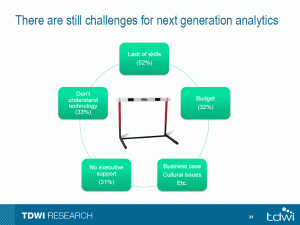This Tuesday, Fern Halper of the TDWI gave a talk on next generation analytics in order to push the latest TDWI report on the topic. I’ll be bouncing between the webinar and the report during this blog entry, but the report is the source for the webinar so use it as the basis. While there were some great nuggets in the study, let’s start off with the overblown title.
As Ms. Halper notes in the executive summary of the report, “Next-generation platforms and analytics often mean simply pushing past reports and dashboards to more advanced forms of analytics, such as predictive analytics.” In other words, anyone doing anything new can define that they’re using next generation analytics, so it doesn’t mean much.
This report is better than a number of others I’ve seen from the TDWI for another thing early in it: The demographics. The positions of respondents seems to be far more balanced between IT and non-IT than others and it lends the report more credibility when discussing business intelligence that matters to business.
The first statistic of note from the webinar is when we were told that 40% of respondents already use advanced analytics. Let’s deal with the bigger number: 60% of respondents, supposedly the cream of the crop who respond to TDWI, are still using basic reporting. That clearly points to a slower adoption than many in the industry acknowledge.
A major part of the reason for that is an inability to build business messages for newer applications and therefore an inability for techies to get the dollars to purchase the new systems. I talk about that a lot in my blog, wonderful technology that gets only slowly adopted because technical messages don’t interest a business audience.
Then there was the slide titled “Dashboards are the most commonly used kind of analytics.” Dashboards aren’t analytics. Dashboards are a way to display analytics. However, as it takes a technology to create dashboards to hold analytics containers, technical folks think technically and get fuzzy. Many of the newer analytics tools, including many providing predictive analytics, embed the new analytics along with others inside dashboards.
One key slide, that might seem obvious but is very important, is about the areas where next generation analytics are being adopted. The top areas are, in order:
- Marketing
- Executive management
- Sales
- Finance
Two of the first three are focused on top line business, revenue, while the other two have to balance top and bottom line. Yes, operations matters and some of those areas aren’t far behind, but the numbers mean something I’ve repeated and will continue to repeat: Techies need to understand the pressures, needs and communications styles of folks they don’t often understand, and must create stories that address those people. If you take anything from the TDWI report, take that.
One pair of subjects in the talk made me shake my head.
First, the top three groups of people using advanced analytics in companies:
- Business Analysts: 75%
- Data Scientists: 56%
- Business Users: 50%
We can see the weight of need overbalanced to business categories, not the mystically names and overpriced data scientist.
The report has a very good summary of how respondents are trying to overcome the challenges of adopting the new BI solutions (page 22, worth downloading the report). Gaining skills is the first part of that and some folks claim their way of doing it is to “Hir[e] fewer but more skilled personnel such as data analysts and data scientists.” Those are probably the folks in the middle bullet above, who think that a priesthood can solve the problem rather than the most likely solution of providing skills and education to the folks who need to use the information.

Fern Halper was very clear about that, even though she’s a data scientist. She pointed out that while executives don’t need to learn how to build models they do need to understand what the new models need and how to use them. While I think that dismisses the capabilities of many executives, it does bring the information forward. The business analysts are going to work with management to create real models that address real world problems. Specialist statistical programmers might be needed for very complex issues, but most of those people will be hired by the BI vendors.
Q&A, to be honest, hit on a problem with TDWI webinars. There were a couple of business questions, but the overwhelming number of questions were clearly from students looking for study and career advice. That leads to a question about the demographics of the audience and how TDWI should handle future webinars. If they want the audience to be business people, they need to market it better and focus on business issues. That means from the reports all the way to Q&A. Yes, TDWI is about technologies that can help business, but adoption will remain slow while the focus is on the former and not the later.
Summary
The latest TWDI Best Practices Report has some interesting information to describe the slow adoption of advanced BI into the marketplace. It has some great nuggets to help vendors focus better on a business audience and suggest IT needs to also pay more attention to their users, and it’s more balanced than other recent reports. However, the presentation of the information still makes the same mistake as that made by many vendors – it’s not creating the clear, overarching business message needed to speed adoption.
If you missed the presentation, don’t both with watching on-demand. However, download the report, it’s worth the read.